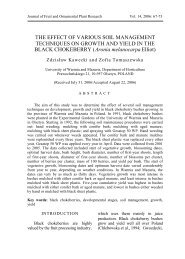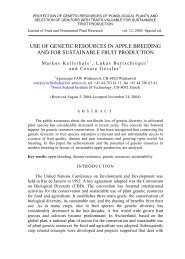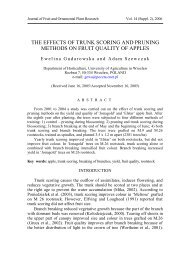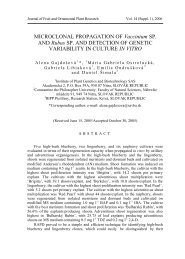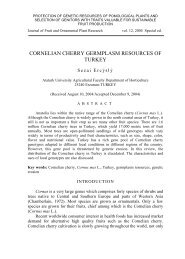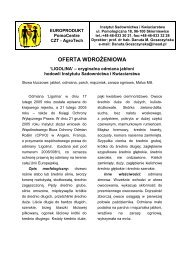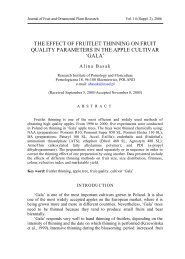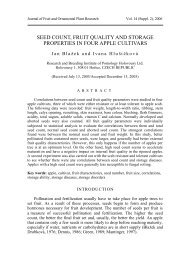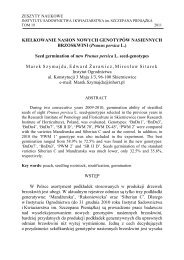Winter-hardy apricots and peaches with good fruit quality in Latvia
Winter-hardy apricots and peaches with good fruit quality in Latvia
Winter-hardy apricots and peaches with good fruit quality in Latvia
Create successful ePaper yourself
Turn your PDF publications into a flip-book with our unique Google optimized e-Paper software.
<strong>W<strong>in</strong>ter</strong><strong>hardy</strong> <strong>apricots</strong> <strong>and</strong> <strong>peaches</strong>…<strong>in</strong> <strong>Latvia</strong>At Dobele, the goal of the apricot breed<strong>in</strong>g program has been to developvarieties <strong>with</strong> firm, freestone <strong>fruit</strong>s weigh<strong>in</strong>g from 40 to 55 grams, <strong>with</strong>sweet, juicy, aromatic flesh, low acidity, <strong>and</strong> a soluble solids content of over20%.MATERIAL AND METHODSApricot breed<strong>in</strong>g has been carried out at the Dobele Horticultural PlantBreed<strong>in</strong>g Experimental Station <strong>and</strong> the Botanical Gardens of the University of<strong>Latvia</strong> s<strong>in</strong>ce the late 1940s. The apricot hybrids at Dobele were developed byP. Upitis us<strong>in</strong>g material from the mounta<strong>in</strong>s of Central Asia. The apricothybrids at the Botanical Gardens were developed by V. Varna us<strong>in</strong>g materialfrom the Ukra<strong>in</strong>e, Belarus, the Voronezh district of Russia, <strong>and</strong> from Horog <strong>in</strong>the Pamir Mounta<strong>in</strong>s. Both Upitis <strong>and</strong> Varna used Prunus armeniaca L.(Straz<strong>in</strong>ska, 1999).Because the climate <strong>in</strong> <strong>Latvia</strong> is not favorable for apricot grow<strong>in</strong>g, thema<strong>in</strong> breed<strong>in</strong>g technique used was mass screen<strong>in</strong>g of local openpoll<strong>in</strong>atedseedl<strong>in</strong>gs. Methodical hybridization <strong>with</strong> carefully selected parental formswas used less often because the weather dur<strong>in</strong>g apricot blossom<strong>in</strong>g season isoften <strong>in</strong>clement.Peach breed<strong>in</strong>g <strong>in</strong> <strong>Latvia</strong> was started <strong>in</strong> 1938 by V. Varna, who grewseedl<strong>in</strong>gs from openpoll<strong>in</strong>ated Italian <strong>peaches</strong> <strong>with</strong> large <strong>fruit</strong>s. After twentyyears of work, he developed ‘Latvijas Persiks’, which belongs to the NorthCh<strong>in</strong>a peach group. In <strong>Latvia</strong>, ‘Latvijas Persiks’ is only moderately w<strong>in</strong>ter<strong>hardy</strong>,but has been used <strong>in</strong> later breed<strong>in</strong>g work.The ma<strong>in</strong> breed<strong>in</strong>g technique used <strong>in</strong> the peach breed<strong>in</strong>g program at theBotanical Gardens of the University of <strong>Latvia</strong> was controlled cross<strong>in</strong>g.Seedl<strong>in</strong>gs from the Botanical Gardens were planted <strong>in</strong> a greenhouse together<strong>with</strong> southern varieties such as ‘Vezuvius’, ‘Nikitny’, <strong>and</strong> ‘Nektar<strong>in</strong> Belii’.The hybrid seeds from various comb<strong>in</strong>ations were then planted <strong>in</strong> an openfield. About 2% of the seedl<strong>in</strong>gs survived until they could bear <strong>fruit</strong>. Later,another technique was used <strong>in</strong> which the hybrid seeds were grown <strong>in</strong> pots <strong>and</strong>not transferred outdoors until they were three years old. This producedseedl<strong>in</strong>gs <strong>with</strong> <strong>good</strong>, mature shoots. 98% of the seedl<strong>in</strong>gs survived until theycould bear <strong>fruit</strong> (Straz<strong>in</strong>ska, 1999). Today, the collection of peach cultivars<strong>and</strong> hybrids at the Botanical Gardens <strong>in</strong>cludes fourth <strong>and</strong> fifth generationseedl<strong>in</strong>gs.<strong>W<strong>in</strong>ter</strong> hard<strong>in</strong>ess <strong>in</strong> <strong>apricots</strong> was studied at Dobele from 1992 to 1997.The material studied consisted of third, fourth <strong>and</strong> fifth generation seedl<strong>in</strong>gsdescended from openpoll<strong>in</strong>ated seedl<strong>in</strong>g planted <strong>in</strong> 1959. The fourth <strong>and</strong> fifthgeneration seedl<strong>in</strong>gs were mostly openpoll<strong>in</strong>ated seedl<strong>in</strong>gs of the mostpromis<strong>in</strong>g genotypes.J. Fruit Ornam. Plant Res. Special ed. vol. 12, 2004: 321329 323




